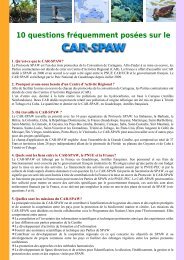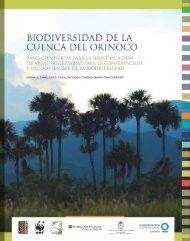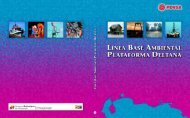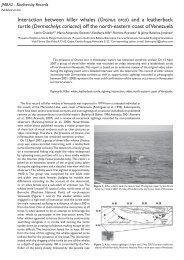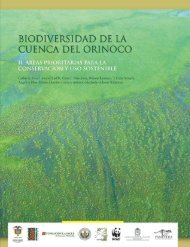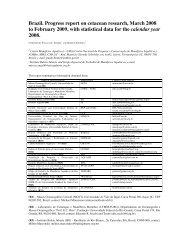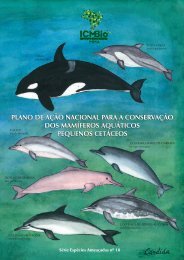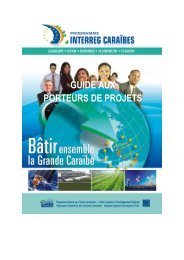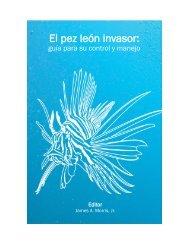Daniel M. Palacios et al. 2012. Cetacean distribution and relative ...
Daniel M. Palacios et al. 2012. Cetacean distribution and relative ...
Daniel M. Palacios et al. 2012. Cetacean distribution and relative ...
- No tags were found...
Create successful ePaper yourself
Turn your PDF publications into a flip-book with our unique Google optimized e-Paper software.
J. CETACEAN RES. MANAGE. 12(1): 45–60, 2012 45C<strong>et</strong>acean <strong>distribution</strong> <strong>and</strong> <strong>relative</strong> abundance in Colombia’sPacific EEZ from survey cruises <strong>and</strong> platforms of opportunityDANIEL M. PALACIOS 1,2 , JULIO C. HERRERA 3 , TIM GERRODETTE 4 , CAROLINA GARCÍA 5,6 , GERMÁN A. SOLER 5 , ISABEL C. AVILA 7,8 ,SANDRA BESSUDO 5 , ELIZABETH HERNÁNDEZ 3 , FERNANDO TRUJILLO 9 , LILIÁN FLÓREZ-GONZÁLEZ 3 AND IAIN KERR 10Contact e-mail: <strong>Daniel</strong>.<strong>P<strong>al</strong>acios</strong>@noaa.govABSTRACTC<strong>et</strong>acean sighting data collected under various programmes in Colombian Pacific waters were collated with the go<strong>al</strong> of assessing the <strong>distribution</strong><strong>and</strong> abundance patterns of <strong>al</strong>l species occurring in the exclusive economic zone (EEZ). Distribution maps are presented for 19 species <strong>and</strong> onegenus based on 603 sightings collected b<strong>et</strong>ween 1986 <strong>and</strong> 2008. Ordered by sighting frequency, these species were: humpback wh<strong>al</strong>e (Megapteranovaeangliae); striped dolphin (Stenella coeruleo<strong>al</strong>ba); common bottlenose dolphin (Tursiops truncatus); pantropic<strong>al</strong> spotted dolphin (Stenellaattenuata); common dolphin (Delphinus delphis); Risso’s dolphin (Grampus griseus); sperm wh<strong>al</strong>e (Phys<strong>et</strong>er macroceph<strong>al</strong>us); rough-tootheddolphin (Steno bredanensis); short-finned pilot wh<strong>al</strong>e (Globiceph<strong>al</strong>a macrorhynchus); mesoplodont wh<strong>al</strong>es (Mesoplodon spp.); Cuvier’s beakedwh<strong>al</strong>e (Ziphius cavirostris); melon-headed wh<strong>al</strong>e (Peponoceph<strong>al</strong>a electra); f<strong>al</strong>se killer wh<strong>al</strong>e (Pseudorca crassidens); killer wh<strong>al</strong>e (Orcinus orca);spinner dolphin (Stenella longirostris); dwarf sperm wh<strong>al</strong>e (Kogia sima); Bryde’s wh<strong>al</strong>e (B<strong>al</strong>aenoptera edeni); pygmy killer wh<strong>al</strong>e (Feresaattenuata); minke wh<strong>al</strong>e (B<strong>al</strong>aenoptera acutorostrata) <strong>and</strong> fin wh<strong>al</strong>e (B<strong>al</strong>aenoptera phys<strong>al</strong>us). Concentrations of sightings were observed in threegeographic areas: (1) the continent<strong>al</strong> shelf (depths
46 PALACIOS <strong>et</strong> <strong>al</strong>.: CETACEAN DISTRIBUTION AND ABUNDANCE IN COLOMBIATable 1List of 23 c<strong>et</strong>acean species whose presence has been confirmed within Colombian Pacific waters.Common name Scientific name SourcePantropic<strong>al</strong> spotted dolphin Stenella attenuata Vid<strong>al</strong> (1990); Flórez-González <strong>and</strong> Capella (1995)Spinner dolphin Stenella longirostris Vid<strong>al</strong> (1990)Striped dolphin Stenella coeruleo<strong>al</strong>ba Vid<strong>al</strong> (1990)Rough-toothed dolphin Steno bredanensis Vid<strong>al</strong> (1990)Common dolphin Delphinus delphis Vid<strong>al</strong> (1990); Flórez-González <strong>and</strong> Capella (1995)Common bottlenose dolphin Tursiops truncatus Vid<strong>al</strong> (1990); Flórez-González <strong>and</strong> Capella (1995)Risso’s dolphin Grampus griseus Vid<strong>al</strong> (1990); Flórez-González <strong>and</strong> Capella (1995)Fraser’s dolphin Lagenodelphis hosei Vid<strong>al</strong> (1990)Melon-headed wh<strong>al</strong>e Peponoceph<strong>al</strong>a electra Vid<strong>al</strong> (1990)Pygmy killer wh<strong>al</strong>e Feresa attenuata Vid<strong>al</strong> (1990)F<strong>al</strong>se killer wh<strong>al</strong>e Pseudorca crassidens Vid<strong>al</strong> (1990); Flórez-González <strong>and</strong> Capella (1995)Short-finned pilot wh<strong>al</strong>e Globiceph<strong>al</strong>a macrorhynchus Vid<strong>al</strong> (1990); Flórez-González <strong>and</strong> Capella (1995)Killer wh<strong>al</strong>e Orcinus orca Vid<strong>al</strong> (1990); Flórez-González <strong>and</strong> Capella (1995)Sperm wh<strong>al</strong>e Phys<strong>et</strong>er macroceph<strong>al</strong>us Vid<strong>al</strong> (1990); Flórez-González <strong>and</strong> Capella (1995)Dwarf sperm wh<strong>al</strong>e Kogia sima Vid<strong>al</strong> (1990); Flórez-González <strong>and</strong> Capella (1995)Blainville’s beaked wh<strong>al</strong>e Mesoplodon densirostris Flórez-González <strong>and</strong> Capella (1995)Cuvier’s beaked wh<strong>al</strong>e Ziphius cavirostris Vid<strong>al</strong> (1990); Flórez-González <strong>and</strong> Capella (1995)Minke wh<strong>al</strong>e B<strong>al</strong>aenoptera acutorostrata Vid<strong>al</strong> (1990)Bryde’s wh<strong>al</strong>e B<strong>al</strong>aenoptera edeni Vid<strong>al</strong> (1990); Flórez-González <strong>and</strong> Capella (1995)Sei wh<strong>al</strong>e B<strong>al</strong>aenoptera bore<strong>al</strong>is Vid<strong>al</strong> (1990)Humpback wh<strong>al</strong>e Megaptera novaeangliae Vid<strong>al</strong> (1990); Flórez-González <strong>and</strong> Capella (1995)Fin wh<strong>al</strong>e B<strong>al</strong>aenoptera phys<strong>al</strong>us Vid<strong>al</strong> (1990)Blue wh<strong>al</strong>e B<strong>al</strong>aenoptera musculus Mora-Pinto <strong>et</strong> <strong>al</strong>. (1995); Van Waerebeek <strong>et</strong> <strong>al</strong>. (1997)1). At least 23 c<strong>et</strong>acean species are known to occur in thesewaters (Flórez-González <strong>and</strong> Capella, 1995; Flórez-González <strong>et</strong> <strong>al</strong>., 2004a; Vid<strong>al</strong>, 1990) (Table 1). Extensivebiologic<strong>al</strong> information <strong>and</strong> a comprehensive conservationstrategy exist for the humpback wh<strong>al</strong>e (Megapteranovaeanglieae) as a product of more than 20 years of study(Flórez-González <strong>et</strong> <strong>al</strong>., 2007). Efforts <strong>al</strong>so have beenundertaken to document the c<strong>et</strong>acean fauna inhabiting thewaters around the isl<strong>and</strong>s of Gorgona (Flórez-González <strong>and</strong>Capella, 2001; Flórez-González <strong>et</strong> <strong>al</strong>., 2004b) <strong>and</strong> M<strong>al</strong>pelo(Herrera <strong>et</strong> <strong>al</strong>., 2007). However, much less is known aboutthe occurrence of c<strong>et</strong>aceans outside these locations, inparticular for those species occurring in offshore waters.Abundance estimates for selected species have beenpresented by Gerrod<strong>et</strong>te <strong>and</strong> <strong>P<strong>al</strong>acios</strong> (1996) based onregion<strong>al</strong>-sc<strong>al</strong>e line-transect surveys for the period 1986–1993(Table 2), but no more recent estimates are available <strong>and</strong> nocomprehensive maps of c<strong>et</strong>acean <strong>distribution</strong> have ever beenpublished for Colombia’s EEZ. This paper presents, for thefirst time, <strong>distribution</strong><strong>al</strong> maps for 19 species <strong>and</strong> one genusoccurring in Colombian waters, based on a compilation ofsightings collected aboard survey cruises <strong>and</strong> platforms ofopportunity b<strong>et</strong>ween 1986 <strong>and</strong> 2008. It <strong>al</strong>so provides, withsome important caveats, group encounter rates <strong>and</strong> typic<strong>al</strong>group sizes to give a more compl<strong>et</strong>e picture of the occurrencepatterns of these species. Fin<strong>al</strong>ly, the paper discusses whathas been learned from these efforts <strong>and</strong> identifies gaps inknowledge <strong>and</strong> research needs.DATA SOURCESSince the purpose was to obtain as compl<strong>et</strong>e a picture aspossible of the patterns of c<strong>et</strong>acean occurrence in Colombia’sPacific EEZ, sightings data were compiled from dedicatedc<strong>et</strong>acean surveys as well as from platforms of opportunityoperating in these waters b<strong>et</strong>ween 1986 <strong>and</strong> 2008. D<strong>et</strong>ails ofthese programmes are as follows.SWFSC line-transect cruisesThe Southwest Fisheries Science Center (SWFSC), part ofthe Nation<strong>al</strong> Marine Fisheries Service (NMFS) of the U.S.Nation<strong>al</strong> Oceanic <strong>and</strong> Atmospheric Administration (NOAA),has conducted systematic line-transect surveys for c<strong>et</strong>aceansthroughout the eastern tropic<strong>al</strong> Pacific (in internation<strong>al</strong> watersas well in the EEZs of sever<strong>al</strong> Centr<strong>al</strong> <strong>and</strong> South AmericanTable 2Estimates of c<strong>et</strong>acean abundance (N, in number of anim<strong>al</strong>s) <strong>and</strong> density (D, in number of anim<strong>al</strong>s per 1,000km 2 ) forColombia’s Pacific EEZ, with lower (N low) <strong>and</strong> upper (N up) limits of the 95% confidence interv<strong>al</strong>s, based on SWFSC lin<strong>et</strong>ransectsurveys conducted b<strong>et</strong>ween 1986 <strong>and</strong> 1993 (source: Gerrod<strong>et</strong>te <strong>and</strong> <strong>P<strong>al</strong>acios</strong>, 1996).Common name Scientific name N N lowN upDPantropic<strong>al</strong> spotted dolphin Stenella attenuata 3,934 1,755 8,820 11.9Striped dolphin Stenella coeruleo<strong>al</strong>ba 25,785 17,324 38,379 78.3Rough-toothed dolphin Steno bredanensis 4,366 1,869 10,200 13.3Common dolphin Delphinus delphis 12,369 4,136 36,989 37.5Common bottlenose dolphin Tursiops truncatus 7,171 3,548 14,493 21.8Risso’s dolphin Grampus griseus 7,266 3,599 14,668 22.1Short-finned pilot wh<strong>al</strong>e Globiceph<strong>al</strong>a macrorhynchus 1,140 450 2,892 3.5Beaked wh<strong>al</strong>es Ziphius cavirostris <strong>and</strong> Mesoplodon spp. 30,784 10,633 89,119 93.4Sperm wh<strong>al</strong>e Phys<strong>et</strong>er macroceph<strong>al</strong>us 1,248 643 2,422 3.8Bryde’s wh<strong>al</strong>e B<strong>al</strong>aenoptera edeni 109 37 321 0.3
J. CETACEAN RES. MANAGE. 12(1): 45–60, 2012 47Fig. 1. Left: Colombia’s exclusive economic zone (EEZ) in the Pacific Ocean (source: DIMAR, 1988). Loc<strong>al</strong>ities mentioned in the text are labelled. Bathym<strong>et</strong>riccontours correspond to the 100, 200, 500, 1,000 <strong>and</strong> 2,000m isobaths (source: SRTM30_PLUS glob<strong>al</strong> topography v.6.0, available from http://topex.ucsd.edu/).Right: Politic<strong>al</strong> boundaries of Colombia <strong>and</strong> its location in the Southeast Pacific.countries) every few years b<strong>et</strong>ween 1986 <strong>and</strong> 2006 (1986–1990, 1992, 1998–2000, 2003 <strong>and</strong> 2006). The purpose ofthese surveys is to estimate population size <strong>and</strong> to monitortrends in the abundance of sever<strong>al</strong> dolphin stocks that havebeen affected by incident<strong>al</strong> mort<strong>al</strong>ity in the internation<strong>al</strong>purse-seine fishery for tuna (Gerrod<strong>et</strong>te, 2002). Them<strong>et</strong>hodology has been documented in d<strong>et</strong>ail elsewhere (e.g.Gerrod<strong>et</strong>te <strong>and</strong> Forcada, 2005; Kinzey <strong>et</strong> <strong>al</strong>., 2000; Wade <strong>and</strong>Gerrod<strong>et</strong>te, 1993), but briefly, the ship-based surveys takeplace from late July to early December following pred<strong>et</strong>erminedr<strong>and</strong>om tracklines at a nomin<strong>al</strong> cruising speed of10 knots (18.5km/h). A team of three observers conduct visu<strong>al</strong>searching for c<strong>et</strong>aceans during daylight hours (dawn to dusk)from the ship’s flying bridge using 25x150mm pedest<strong>al</strong>mountedbinoculars in sea state conditions ranging from 0 to6 in the Beaufort sc<strong>al</strong>e. Angle <strong>and</strong> radi<strong>al</strong> distance to eachsighting are recorded upon initi<strong>al</strong> sighting, <strong>and</strong> the ship is thendiverted to approach the anim<strong>al</strong>s in order to obtain speciesidentity <strong>and</strong> group size. B<strong>et</strong>ween 1986 <strong>and</strong> 2000, two 52mresearch vessels, the McArthur <strong>and</strong> the David Starr Jordan,were used, both having an observation height of 11m abov<strong>et</strong>he water line. An addition<strong>al</strong> ship, the 57m R/V Endeavor,with an observation height of 10m, was used during the 1998survey. Starting with the 2003 survey, the McArthur wasreplaced with the 68m McArthur II, with an observationheight of 15m.The Siben <strong>and</strong> Odyssey expeditionsTwo expeditions to study c<strong>et</strong>aceans in South Americanwaters were conducted under the joint auspices of the OceanAlliance (under the former names of Long-term ResearchInstitute <strong>and</strong> Wh<strong>al</strong>e Conservation Institute) <strong>and</strong> the InterpolarResearch Soci<strong>et</strong>y. The purpose of these expeditions was tostudy the biology of the sperm wh<strong>al</strong>e (Phys<strong>et</strong>ermacroceph<strong>al</strong>us) <strong>and</strong> the humpback wh<strong>al</strong>e while providingtraining in c<strong>et</strong>acean research techniques to loc<strong>al</strong> scientists(see <strong>al</strong>so Pardo <strong>et</strong> <strong>al</strong>., 2009). The first expedition operated inColombian waters aboard the R/V Siben, a 25.9m sailboat,b<strong>et</strong>ween May <strong>and</strong> July 1998 (Torres <strong>et</strong> <strong>al</strong>., 1988), while thesecond one took place at various times during 1993(February, September, October) <strong>and</strong> 1994 (April) aboard theR/V Odyssey, a 28.4m sailboat (Ocean Alliance, unpublisheddata). On both ships, two observers maintained visu<strong>al</strong>watches during daylight hours (07:00–18:00h, weatherpermitting), using the naked eye or h<strong>and</strong>-held binoculars. Onthe Siben, the observation was conducted from the bow <strong>and</strong>the stern (3–4m above the waterline), while on the Odysseyobservers were positioned atop the ship’s pilothouse (4mabove the waterline) <strong>and</strong> in the crow’s nest on the main mast(18m above the waterline). Sightings of other c<strong>et</strong>aceanspecies were recorded while searching for the targ<strong>et</strong> speciesbut the associated search effort data were not available.DIMAR oceanographic cruisesThe Dirección Gener<strong>al</strong> Marítima de Colombia (DIMAR),through its Centro de Control de Contaminación del Pacífico(CCCP), conducts long-term studies of the El Niñophenomenon in Colombia’s Pacific EEZ with a series ofbiannu<strong>al</strong> oceanographic cruises known as ‘Pacífico’ (norm<strong>al</strong>lyin February or March) <strong>and</strong> ‘ERFEN’ (in September). Eachcruise uses one of two ships, either R/V Providencia or R/VM<strong>al</strong>pelo, both 50.9m long, <strong>and</strong> takes about 20 effective seadays to compl<strong>et</strong>e. Two nation<strong>al</strong> non-profit organisations,Fundación Yubarta <strong>and</strong> Fundación M<strong>al</strong>pelo, have placedmarine mamm<strong>al</strong> observers on seven of these cruises b<strong>et</strong>ween2004 <strong>and</strong> 2008. Observation effort takes place during travel
48 PALACIOS <strong>et</strong> <strong>al</strong>.: CETACEAN DISTRIBUTION AND ABUNDANCE IN COLOMBIAb<strong>et</strong>ween oceanographic stations at a cruising speed of 10 knotsfor M<strong>al</strong>pelo (18.5km/h) <strong>and</strong> 11 knots (20.4km/h) forProvidencia. An observer searches for c<strong>et</strong>aceans from theship’s flying bridge 10m above the water line using 7x50mmh<strong>and</strong>-held binoculars. Unlike the SWFSC surveys, sightingsare not closed on, so only c<strong>et</strong>acean groups that occur near theship can be identified <strong>and</strong> counted. For this reason, searcheffort is only conducted under acceptable viewing conditions(no fog or rain, <strong>and</strong> in Beaufort sea states of 3 or less).Dive <strong>and</strong> Seascape charter tripsFundación M<strong>al</strong>pelo <strong>and</strong> Fundación Yubarta have <strong>al</strong>so placedmarine mamm<strong>al</strong> observers on 39 chartered trips to theoffshore isl<strong>and</strong>s of M<strong>al</strong>pelo <strong>and</strong> Gorgona b<strong>et</strong>ween 2004 <strong>and</strong>2008. Twenty-four of these were dive trips organised by thecompany Embarcaciones Asturias <strong>and</strong> 17 were dedicatedresearch trips conducted under the auspices of ConservationInternation<strong>al</strong>’s ‘Eastern Tropic<strong>al</strong> Pacific Seascape Program.’One addition<strong>al</strong> dive charter trip in 2008 organised byFundación Cabo Mar covered the coast<strong>al</strong> segment from CaboMarzo-Buenaventura. All trips used M/V Maria Patricia,which has a cruising speed of 8 knots (14.8km/h).Observations took place during transit b<strong>et</strong>ween theoriginating port (Buenaventura) <strong>and</strong> the isl<strong>and</strong> destinationsas well as during transit b<strong>et</strong>ween destinations. Searching wasconducted by one to three observers from the vessel’s topdeck at a height of 4m above the waterline under acceptableviewing conditions (no fog or rain, <strong>and</strong> in Beaufort sea statesof 3 or less). The vessel was diverted to approach sightingswhen conditions <strong>al</strong>lowed during the Seascape trips but notduring the dive trips. Sightings collected at the dive sites (i.e.at anchor or while circumnavigating the isl<strong>and</strong>s) wereremoved from the data s<strong>et</strong> to avoid introducing bias by isl<strong>and</strong>associatedcommunities at these biologic<strong>al</strong>ly rich loc<strong>al</strong>ities.Sports-fishing charter tripsC<strong>et</strong>acean observations were collected on coast<strong>al</strong> sportsfishingtrips organised by Fundación Cabo Mar b<strong>et</strong>ween2000–2001 <strong>and</strong> 2004–2008. During these periods, 20 dailytrips were conducted <strong>al</strong>ong one of three coast<strong>al</strong> routes:Buenaventura-Bahía Solano, Bahía Solano-Cupica <strong>and</strong>Cupica-Cabo Marzo. An addition<strong>al</strong> route b<strong>et</strong>ween theloc<strong>al</strong>ity of El V<strong>al</strong>le <strong>and</strong> offshore waters was covered on oneoccasion. Two fiberglass boats with outboard engines wereused: M/V La Cotizada (23ft long, two 40hp engines)b<strong>et</strong>ween 2000 <strong>and</strong> 2005; <strong>and</strong> M/V El Gran Blanco (32ft, two115hp engines) b<strong>et</strong>ween 2006 <strong>and</strong> 2008. Two observerslocated near the boat’s bow collected sighting data at a heightof 2.2m <strong>and</strong> 2.7m above the water line, respectively for eachboat. Travel speed was variable, ranging b<strong>et</strong>ween 12 <strong>and</strong>30km/h depending on navigation conditions.DATA ANALYSISSighting categoriesIn the field, sightings were classified under 38 differentidentification categories including subspecies, species <strong>and</strong>higher taxonomic levels such as genus, family, <strong>et</strong>c. Foran<strong>al</strong>ysis purposes, sever<strong>al</strong> of these categories were pooledinto more manageable or meaningful species groupings asfollows. Species having sever<strong>al</strong> recognised subspecies orsighting categories (see Dizon <strong>et</strong> <strong>al</strong>., 1994) were pooled intoa single species. Thus, a single ‘pantropic<strong>al</strong> spotted dolphin(Stenella attenuata)’ category was created from threecategories: offshore; coast<strong>al</strong> <strong>and</strong> unidentified subspecies.Similarly, a ‘spinner dolphin (Stenella longirostris)’ categorywas created by pooling four categories: eastern; whitebelly;Centr<strong>al</strong> American <strong>and</strong> unidentified subspecies. Conversely,sightings possibly belonging to sever<strong>al</strong> related species werecombined into a single category when field identification tospecies level was not possible due to inconspicuousbehaviour <strong>and</strong>/or lack of easily distinguishable features. Thiswas the case for unidentified sightings in the genusMesoplodon, for which a ‘mesoplodont wh<strong>al</strong>es (Mesoplodonspp.)’ category was created by pooling sightings ofBlainville’s beaked wh<strong>al</strong>e (M. densirostris) with sightingsidentified to the genus level only.A single-species category was created by pooling confirmedsightings of the targ<strong>et</strong> species with sightings belonging eitherto the targ<strong>et</strong> species or to a related species when the two aredifficult to separate in the field. This was done only in caseswhere biogeographic evidence indicates that the presence ofthe related species in the study area is unlikely or extremelyrare. Thus, a ‘Bryde’s wh<strong>al</strong>e (B<strong>al</strong>aenoptera edeni)’ categorywas created by pooling sightings positively identified asBryde’s wh<strong>al</strong>es (i.e., when the auxiliary ridges on the head ofthe anim<strong>al</strong> were clearly seen) with those identified as ‘eithersei (B. bore<strong>al</strong>is) or Bryde’s wh<strong>al</strong>es’ (i.e. when a very closeexamination at the anim<strong>al</strong>’s head was not obtained <strong>and</strong>therefore identification remained uncertain). Positiveidentification of the sei wh<strong>al</strong>e in the field can be very difficult,but no confirmed sightings of this species have been madeanywhere in the eastern tropic<strong>al</strong> Pacific during the longst<strong>and</strong>ingsurveys by the SWFSC. In a similar manner, a ‘dwarfsperm wh<strong>al</strong>e (Kogia sima)’ category was created by poolingsightings positively identified as dwarf sperm wh<strong>al</strong>es withthose identified as Kogia sp. In this case, it is possible thatsome of the Kogia sp. sightings belonged to the pygmy spermwh<strong>al</strong>e (K. breviceps), <strong>al</strong>though only one confirmed sightingof this species has been reported south of 24°N by theextensive SWFSC surveys.Sightings classified under nine ‘unidentified’ categories:unidentified beaked wh<strong>al</strong>e; unidentified rorqu<strong>al</strong>(B<strong>al</strong>aenoptera sp.); unidentified dolphin; unidentified sm<strong>al</strong>lwh<strong>al</strong>e; unidentified large wh<strong>al</strong>e; unidentified c<strong>et</strong>acean;unidentified wh<strong>al</strong>e; unidentified sm<strong>al</strong>l delphinid <strong>and</strong>unidentified medium delphinid, were not used in this study.In this manner, 20 sighting categories are reported here: 19individu<strong>al</strong> species <strong>and</strong> the genus Mesoplodon.Encounter ratesSpecies encounter rates were computed for each data sourceseparately (except for the Siben <strong>and</strong> Odyssey expeditions,which lacked effort data), based on the sightings recordedwhile search effort was being conducted. These are reportedas group sightings per unit search effort in Appendices 1–5using the origin<strong>al</strong> measurement unit recorded (i.e. kilom<strong>et</strong>ersor hours). Since the m<strong>et</strong>hodology for group size estimationwas variable among the different sources (see section on‘Biases <strong>and</strong> caveats’), average group size was not used in thec<strong>al</strong>culation of <strong>relative</strong> abundance to avoid introducing furtherbias. For ease in presentation <strong>and</strong> discussion, the estimatedencounter rates for <strong>al</strong>l sources are summarised in Table 3 in
J. CETACEAN RES. MANAGE. 12(1): 45–60, 2012 49the same units (groups per km sc<strong>al</strong>ed by 1,000). This wasaccomplished by multiplying the effort hours collected bythe dive/Seascape <strong>and</strong> the sports-fishing trips by the vesselspeed (14.8km/h <strong>and</strong> an average 21km/h, respectively).Due to m<strong>et</strong>hodologic<strong>al</strong> differences, direct comparison ofthe estimated encounter rates b<strong>et</strong>ween sources would beproblematic (see ‘Biases <strong>and</strong> caveats’ in the next section).Nevertheless, we attempt to provide interpr<strong>et</strong>ation byaccording each species a qu<strong>al</strong>itative rank based on theaverage encounter rate from <strong>al</strong>l sources, where ‘low’corresponds to species with encounter rates of less than 1group per 1,000km, ‘intermediate’ to species with encounterrates b<strong>et</strong>ween 1 <strong>and</strong> 3 groups per 1,000km <strong>and</strong> ‘high’ tospecies with encounter rates greater than 3 groups per1,000km (Table 3).Sighting frequency <strong>and</strong> group size statisticsAll identified on-effort sightings were pooled into a singledata s<strong>et</strong> containing a tot<strong>al</strong> of 488 records. Sighting frequencyis reported as the number of sightings for each species in thisdata s<strong>et</strong>. Group size statistics (range, average, median <strong>and</strong>st<strong>and</strong>ard deviation) for each species were computed from thisdata s<strong>et</strong>.DistributionIdentified sightings from <strong>al</strong>l sources, including thosecollected during non-effort periods or from sources with nosearch effort data <strong>and</strong> in <strong>al</strong>l Beaufort sea state conditions,were combined into a single data s<strong>et</strong> containing a tot<strong>al</strong> of 603records belonging to the 20 sighting categories. Species<strong>distribution</strong> maps were created based on these data.RESULTS AND DISCUSSIONEffort <strong>and</strong> associated sightingsSWFSC (1986–2006)A tot<strong>al</strong> of 7,784km of visu<strong>al</strong> effort were traversed by NOAAvessels during the SWFSC line-transect surveys inColombian waters (Fig. 2a). A tot<strong>al</strong> of 238 identifiedsightings were made while on-effort belonging to 16 species<strong>and</strong> the genus Mesoplodon (see Appendix 1).Siben <strong>and</strong> Odyssey expeditions (1988, 1993, 1994)The Siben Expedition in Colombian waters consisted of threelegs during which 11 sightings of six species were collected,while the Odyssey Expedition consisted of four legs duringwhich eight sightings of four species were collected (seeAppendix 2). The routes followed by both expeditions areshown in Fig. 2b.DIMAR (2004–2008)A tot<strong>al</strong> of 8,587km of effort <strong>and</strong> 178 sightings belonging to14 species <strong>and</strong> the genus Mesoplodon were recorded aboardDIMAR vessels during on-effort periods (see Appendix 3).A map of the cruise tracks while on effort is shown inFig. 2c.Dive <strong>and</strong> Seascape trips (2004–2008)A tot<strong>al</strong> of 264hr (3,907km) of effort <strong>and</strong> 46 sightingsbelonging to 13 species were recorded during the transitsb<strong>et</strong>ween Buenaventura <strong>and</strong> the diving destinations (seeAppendix 4). A map of the effort segments for these trips isshown in Fig. 2d.Sports-fishing trips (2000–2001 <strong>and</strong> 2004–2008)A tot<strong>al</strong> of 108hr (2,268km) of observation were conductedduring which 26 c<strong>et</strong>acean sightings belonging to four specieswere recorded (see Appendix 5). A schematic map of thedaily routes is presented in Fig. 3.Patterns of c<strong>et</strong>acean occurrenceThe compiled sightings data s<strong>et</strong> contained records for 19c<strong>et</strong>acean species <strong>and</strong> one genus within Colombia’s PacificEEZ. Distribution maps for these taxa are presented in Figs4–6. Of the 23 species previously reported in these waters(Table 1) only three were absent from our data s<strong>et</strong>: Fraser’sdolphin (Lagenodelphis hosei); sei wh<strong>al</strong>e <strong>and</strong> blue wh<strong>al</strong>eTable 3Estimated encounter rates (in groups per 1,000km) by source for 19 c<strong>et</strong>acean species <strong>and</strong> one genus, based on the on-effort sightings. The ranked encounterrate (low < 1, 1 ≤ intermediate < 3, <strong>and</strong> high ≥ 3 groups per 1,000km) is based on the average from <strong>al</strong>l sources (in parenthesis) <strong>and</strong> is arbitrary.Common name Species name SWFSC DIMAR Dive/seascape Sports-fishing Ranked encounter ratePantropic<strong>al</strong> spotted dolphin* Stenella attenuata 1.93 1.86 1.28 4.08 Intermediate (2.29)Spinner dolphin* Stenella longirostris 0.39 0.26 Low (0.32)Striped dolphin Stenella coeruleo<strong>al</strong>ba 8.99 2.21 1.54 High (4.25)Rough-toothed dolphin Steno bredanensis 1.54 0.47 0.26 Low (0.76)Common dolphin Delphinus delphis 1.67 0.70 2.82 Intermediate (1.73)Common bottlenose dolphin Tursiops truncatus 3.21 2.45 2.82 5.44 High (3.48)Risso’s dolphin Grampus griseus 3.21 0.35 0.26 Intermediate (1.27)Melon-headed wh<strong>al</strong>e Peponoceph<strong>al</strong>a electra 0.64 0.26 Low (0.45)Pygmy killer wh<strong>al</strong>e Feresa attenuata 0.26 Low (0.26)F<strong>al</strong>se killer wh<strong>al</strong>e Pseudorca crassidens 0.23 0.77 0.45 Low (0.48)Short-finned pilot wh<strong>al</strong>e Globiceph<strong>al</strong>a macrorhynchus 0.77 0.70 0.51 Low (0.66)Killer wh<strong>al</strong>e Orcinus orca 0.26 0.12 0.51 Low (0.30)Sperm wh<strong>al</strong>e Phys<strong>et</strong>er macroceph<strong>al</strong>us 3.47 0.23 Intermediate (1.85)Dwarf sperm wh<strong>al</strong>e* Kogia sima 0.51 Low (0.51)Mesoplodont wh<strong>al</strong>es* Mesoplodon spp. 1.41 0.12 Low (0.77)Cuvier’s beaked wh<strong>al</strong>e Ziphius cavirostris 0.51 0.23 0.26 Low (0.33)Minke wh<strong>al</strong>e B<strong>al</strong>aenoptera acutorostrata 0.12 Low (0.12)Bryde’s wh<strong>al</strong>e* B<strong>al</strong>aenoptera edeni 0.51 Low (0.51)Fin wh<strong>al</strong>e B<strong>al</strong>aenoptera phys<strong>al</strong>us 0.12 Low (0.12)Humpback wh<strong>al</strong>e Megaptera novaeangliae 1.28 10.83 0.26 1.81 High (3.55)*Pooling of related sighting categories was done for these species as described in the text.
50 PALACIOS <strong>et</strong> <strong>al</strong>.: CETACEAN DISTRIBUTION AND ABUNDANCE IN COLOMBIAFig. 2. (a) On-effort segments of trackline followed by NOAA vessels during SWFSC line-transect surveys (1986–2006). (b) Tracks followed by the SibenExpedition (May–July 1988) (solid black line) <strong>and</strong> the Odyssey Expedition (February 1993, September–October 1993 <strong>and</strong> April 1994) (dashed black line).(c) On-effort segments of trackline followed by DIMAR vessels during oceanographic cruises (2004, 2006–2008). (d) On-effort segments of tracklinefollowed by M/V Maria Patricia during dive <strong>and</strong> Seascape charter trips (2004–2008). For clarity, only the bathym<strong>et</strong>ric contours corresponding to the 100m(black) <strong>and</strong> 2,000m (gray) isobaths are shown (source as in Fig. 1).(B<strong>al</strong>aenoptera musculus), suggesting they are exceedinglyrare in the region. The estimated encounter rates for the 19species are summarised in Table 3 for <strong>al</strong>l sources for whicheffort data were available. Although density was not estimated,the following species accounts include a comparison of thedensity v<strong>al</strong>ues reported by Gerrod<strong>et</strong>te <strong>and</strong> <strong>P<strong>al</strong>acios</strong> (1996) forselected species in Colombia’s EEZ with the correspondingdensity estimates for the neighbouring waters of Panamá <strong>and</strong>Ecuador, to give a region<strong>al</strong> context. The aim is to provide asynthesis of information on c<strong>et</strong>acean occurrence in Colombia’sPacific EEZ, while warning about its biases <strong>and</strong> limitations.Pantropic<strong>al</strong> spotted dolphin (Stenella attenuata)This species was well represented in inshore waters, wheresightings tended to occur in clusters around Gorgona Isl<strong>and</strong>(where it is a year-round resident; Flórez-González <strong>and</strong>Capella, 2001), outside Bahía de Buenaventura <strong>and</strong> fromGolfo de Cupica to the Panamá border (Fig. 4a). Multiplescattered sightings <strong>al</strong>so occurred throughout the offshoreregion. This pattern probably corresponds to the coast<strong>al</strong> <strong>and</strong>offshore subspecies (Dizon <strong>et</strong> <strong>al</strong>., 1994; Escorza-Treviño <strong>et</strong><strong>al</strong>., 2005), as both were reported in the data. Pantropic<strong>al</strong>spotted dolphin had an intermediate ranked encounter rate(Table 3) <strong>and</strong> it was the fourth most frequently sighted species(Table 4). Average group size was 94 <strong>and</strong> the range was 2–400 (Table 4). Based on an earlier data s<strong>et</strong>, Gerrod<strong>et</strong>te <strong>and</strong><strong>P<strong>al</strong>acios</strong> (1996) reported a density estimate for Colombia’sEEZ of 11.9 pantropic<strong>al</strong> spotted dolphins per 1,000km 2 (Table2). This number is substanti<strong>al</strong>ly lower than the density estimatefor Panamá’s EEZ (58.8 anim<strong>al</strong>s per 1,000km 2 ) to the north,but higher than that for Ecuador’s EEZ (8.3 anim<strong>al</strong>s per1,000km 2 ) to the south (Gerrod<strong>et</strong>te <strong>and</strong> <strong>P<strong>al</strong>acios</strong>, 1996).Spinner dolphin (Stenella longirostris)The few spinner dolphin sightings in the data s<strong>et</strong> were madeon the slope <strong>and</strong> over the M<strong>al</strong>pelo Ridge (Fig. 4a). Threesubspecies or forms of this species were reported withinColombia’s EEZ: eastern (S. l. orient<strong>al</strong>is); whitebelly (apresumed hybrid b<strong>et</strong>ween S. l. longirostris <strong>and</strong> S. l.orient<strong>al</strong>is) <strong>and</strong> Centr<strong>al</strong> American (S. l. centroamericana)(Dizon <strong>et</strong> <strong>al</strong>., 1994). The ranked encounter rate was low forthis species (Table 3). Average spinner dolphin group sizewas 96 <strong>and</strong> the range was 1–226 (Table 4).Striped dolphin (Stenella coerueo<strong>al</strong>ba)The species was well distributed in offshore waters <strong>and</strong>absent from inshore waters (Fig. 4b). Striped dolphin had ahigh ranked encounter rate (Table 3) <strong>and</strong> it was the second
J. CETACEAN RES. MANAGE. 12(1): 45–60, 2012 514). The existing density estimate for this species inColombia’s EEZ (37.5 anim<strong>al</strong>s per 1,000km 2 ; Table 2) issubstanti<strong>al</strong>ly lower than that reported for Panamá (129.4anim<strong>al</strong>s per 1,000km 2 ) or Ecuador (402.2 anim<strong>al</strong>s per1,000km 2 ) (Gerrod<strong>et</strong>te <strong>and</strong> <strong>P<strong>al</strong>acios</strong>, 1996).Common bottlenose dolphin (Tursiops truncatus)Like the pantropic<strong>al</strong> spotted dolphin, this species was wellrepresented in inshore waters, with multiple sightingsscattered throughout the offshore region as well (Fig. 4d).This suggests the occurrence of inshore <strong>and</strong> offshore ecotypesknown from around the world (e.g. Natoli <strong>et</strong> <strong>al</strong>., 2004). Mostof the inshore sightings occurred north of 4°N, especi<strong>al</strong>lyb<strong>et</strong>ween Bahía Solano <strong>and</strong> Cabo Marzo, <strong>and</strong> in the offshoreregion sever<strong>al</strong> occurred over the Mapelo Ridge (Fig. 4d).Bottlenose dolphin had a high ranked encounter rate (Table3) <strong>and</strong> it was the third most frequently sighted species in thecombined data s<strong>et</strong> (Table 4). Average group size was 25 <strong>and</strong>the range was 1–300 (Table 4). The existing density estimatefor common bottlenose dolphin in Colombia’s EEZ (21.8anim<strong>al</strong>s per 1,000km 2 ; Table 2) is substanti<strong>al</strong>ly lower thanthat reported for Panamá (53.3 anim<strong>al</strong>s per 1,000km 2 ), <strong>and</strong>somewhat lower than that reported for Ecuador (26.5 anim<strong>al</strong>sper 1,000km 2 ) (Gerrod<strong>et</strong>te <strong>and</strong> <strong>P<strong>al</strong>acios</strong>, 1996).Fig. 3. Typic<strong>al</strong> daily routes followed by the coast<strong>al</strong> sports-fishing trips(2000–2001, 2004–2008). Encircled numbers correspond to: (1)Buenaventura-Bahía Solano route; (2) Bahía Solano-Cupica route; (3)Cupica-Cabo Marzo route <strong>and</strong> (4) El V<strong>al</strong>le-offshore route. Bathym<strong>et</strong>riccontours correspond to the 100, 200, 500, 1,000 <strong>and</strong> 2,000m isobaths(source as in Fig. 1).most frequently sighted species in the data s<strong>et</strong> (Table 4).Average group size was 71 <strong>and</strong> the range was 3–1,500 (Table4). According to Gerrod<strong>et</strong>te <strong>and</strong> <strong>P<strong>al</strong>acios</strong> (1996), stripeddolphin is probably the most abundant dolphin species inColombia’s EEZ (Table 2). The existing density estimate forthis species in Colombia’s EEZ (78.2 anim<strong>al</strong>s per 1,000km 2 ;Table 2) is somewhat higher than that reported for Panamá(64.3 anim<strong>al</strong>s per 1,000km 2 ) or Ecuador (72.6 anim<strong>al</strong>s per1,000km 2 ) (Gerrod<strong>et</strong>te <strong>and</strong> <strong>P<strong>al</strong>acios</strong>, 1996).Rough-toothed dolphin (Steno bredanensis)The species occurred in the offshore region, mostly south of5°N (Fig. 4c). Rough-toothed dolphin had a low rankedencounter rate (Table 3). Average group size was 35 <strong>and</strong> therange was 5–90 (Table 4). The existing density estimate forthe species in Colombia’s EEZ (13.3 anim<strong>al</strong>s per 1,000km 2 ;Table 2) is higher than that reported for Panamá (6.9 anim<strong>al</strong>sper 1,000km 2 ) (Gerrod<strong>et</strong>te <strong>and</strong> <strong>P<strong>al</strong>acios</strong>, 1996).Common dolphin (Delphinus delphis)Common dolphins were found primarily in offshore waters,especi<strong>al</strong>ly in the northeastern part of the EEZ (including thevicinity of Cabo Marzo) (Fig. 4c). This species had anintermediate ranked encounter rate (Table 3) <strong>and</strong> it was thefifth most frequently sighted in the data s<strong>et</strong> (Table 4).Average group size was 155 <strong>and</strong> the range was 3–800 (TableRisso’s dolphin (Grampus griseus)This dolphin was found primarily in offshore waters,including over the Mapelo Ridge (Fig. 4d). Rankedencounter rate was intermediate for this species (Table 3).Average group size was 13 <strong>and</strong> the range was 1–59 (Table4). The existing density estimate for Risso’s dolphin inColombia’s EEZ (22.1 anim<strong>al</strong>s per 1,000km 2 ; Table 2) ishigher than that reported for Panamá (12.7 anim<strong>al</strong>s per1,000km 2 ) (Gerrod<strong>et</strong>te <strong>and</strong> <strong>P<strong>al</strong>acios</strong>, 1996).Melon-headed wh<strong>al</strong>e (Peponoceph<strong>al</strong>a electra)The h<strong>and</strong>ful of sightings of melon-headed wh<strong>al</strong>e in thedatabase were made south of 5°N just offshore of thecontinent<strong>al</strong> slope (Fig. 5a). Ranked encounter rate was lowfor this species (Table 3). Average group size was 206 <strong>and</strong>the range was 10–434 (Table 4).Pygmy killer wh<strong>al</strong>e (Feresa attenuata)Only two sightings were collected for this species, one ofwhich occurred over the M<strong>al</strong>pelo Ridge (Fig. 5a). Rankedencounter rate was low for this species (Table 3). Averagegroup size was 35 <strong>and</strong> the range was 25–45 (Table 4).F<strong>al</strong>se killer wh<strong>al</strong>e (Pseudorca crassidens)Of the eight f<strong>al</strong>se killer wh<strong>al</strong>e sightings in the combined datas<strong>et</strong>, four were made offshore near the M<strong>al</strong>pelo Ridge <strong>and</strong> theremaining four were made near Cabo Marzo, in the northeastcorner of the EEZ (Fig. 5a). Ranked encounter rate for thisspecies was low (Table 3). Average group size was 62 <strong>and</strong>the range was 2–300 (Table 4).Short-finned pilot wh<strong>al</strong>e (Globiceph<strong>al</strong>a macrorhynchus)This species was well distributed throughout the offshoreregion, including over the M<strong>al</strong>pelo Ridge, but one sightingwas made in the northeast corner of the EEZ near the border
52 PALACIOS <strong>et</strong> <strong>al</strong>.: CETACEAN DISTRIBUTION AND ABUNDANCE IN COLOMBIAFig. 4. Distribution maps in Colombia’s Pacific EEZ based on sightings from <strong>al</strong>l sources combined (1986–2008) for: (a) pantropic<strong>al</strong> spotted dolphin (Stenellaattenuata) <strong>and</strong> spinner dolphin (Stenella longirostris); (b) striped dolphin (Stenella coeruleo<strong>al</strong>ba); (c) common dolphin (Delphinus delphis) <strong>and</strong> roughtootheddolphin (Steno bredanensis) <strong>and</strong> (d) common bottlenose dolphin (Tursiops truncatus) <strong>and</strong> Risso’s dolphin (Grampus griseus). The number ofsightings for each species is indicated. For clarity, only the bathym<strong>et</strong>ric contours corresponding to the 100m (black) <strong>and</strong> 2,000m (gray) isobaths are shown(source as in Fig. 1).with Panamá (Fig. 5b). Short-finned pilot wh<strong>al</strong>e rankedencounter rate was low (Table 3). Average group size was 16<strong>and</strong> the range was 1–80 (Table 4). The existing densityestimate for this species in Colombia’s EEZ (3.5 anim<strong>al</strong>s per1,000km 2 ; Table 2) is substanti<strong>al</strong>ly lower than that reportedfor Panamá (15.2 anim<strong>al</strong>s per 1,000km 2 ) or Ecuador (13.1anim<strong>al</strong>s per 1,000km 2 ) (Gerrod<strong>et</strong>te <strong>and</strong> <strong>P<strong>al</strong>acios</strong>, 1996).Killer wh<strong>al</strong>e (Orcinus orca)The few sightings of this species were scattered in theoffshore region south of 4°N (Fig. 5b). Killer wh<strong>al</strong>e rankedencounter rate was low (Table 3). Average group size was 5<strong>and</strong> the range was 3–8 (Table 4).Sperm wh<strong>al</strong>e (Phys<strong>et</strong>er macroceph<strong>al</strong>us)Sperm wh<strong>al</strong>e was distributed primarily in the offshore region,including over the M<strong>al</strong>pelo Ridge (Fig. 5c). Rankedencounter rate for this species was intermediate (Table 3).Average group size was 10 <strong>and</strong> the range was 1–34 (Table 4).It is worth noting that despite <strong>relative</strong>ly continuous coverageb<strong>et</strong>ween 1986 <strong>and</strong> 2008, <strong>al</strong>l but two sightings were made priorto 1998, suggesting that sperm wh<strong>al</strong>e has shifted its<strong>distribution</strong> in recent years <strong>and</strong> that it is no longer present inthe Colombian EEZ in the same numbers as in the early yearsof sampling. The home range of the sperm wh<strong>al</strong>e in theeastern tropic<strong>al</strong> Pacific spans ~2,000km (Whitehead <strong>et</strong> <strong>al</strong>.,2008), <strong>and</strong> hence it is possible that the observed trend is, atleast in part, a reflection of the species’ multi-yeardisplacements throughout the region. The existing spermwh<strong>al</strong>e density estimate in Colombia (3.8 anim<strong>al</strong>s per1,000km 2 ; Table 2) is based on data for the period 1986–1993<strong>and</strong> is somewhat lower than that reported for Panamá (5.3anim<strong>al</strong>s per 1,000km 2 ) or Ecuador (5.4 anim<strong>al</strong>s per 1,000km 2 )for the same period (Gerrod<strong>et</strong>te <strong>and</strong> <strong>P<strong>al</strong>acios</strong>, 1996).Dwarf sperm wh<strong>al</strong>e (Kogia sima)There were few sightings of dwarf sperm wh<strong>al</strong>e, which werescattered over the slope <strong>and</strong> in the offshore region, <strong>al</strong>thoughone sighting was made near Cabo Marzo, in the northeastcorner of the EEZ (Fig. 5c). This species had a low rankedencounter rate (Table 3) <strong>and</strong> was only sighted during SWFSCsurveys. Average group size was 2 <strong>and</strong> the range was 1–3(Table 4).Mesoplodont wh<strong>al</strong>es (Mesoplodon spp.)Mesoplodont wh<strong>al</strong>es were well distributed in the offshoreregion south of 5°N, including over the M<strong>al</strong>pelo Ridge (Fig.5d). Two sightings <strong>al</strong>so were made near Cabo Marzo, in the
J. CETACEAN RES. MANAGE. 12(1): 45–60, 2012 53Fig. 5. Distribution maps in Colombia’s Pacific EEZ based on sightings from <strong>al</strong>l sources combined (1986–2008) for: (a) f<strong>al</strong>se killer wh<strong>al</strong>e (Pseudorcacrassidens), melon-headed wh<strong>al</strong>e (Peponoceph<strong>al</strong>a electra) <strong>and</strong> pygmy killer wh<strong>al</strong>e (Feresa attenuata); (b) short-finned pilot wh<strong>al</strong>e (Globiceph<strong>al</strong>amacrorhynchus) <strong>and</strong> killer wh<strong>al</strong>e (Orcinus orca); (c) sperm wh<strong>al</strong>e (Phys<strong>et</strong>er macroceph<strong>al</strong>us) <strong>and</strong> dwarf sperm wh<strong>al</strong>e (Kogia sima); <strong>and</strong> (d) mesoplodontwh<strong>al</strong>es (Mesoplodon spp.) <strong>and</strong> Cuvier’s beaked wh<strong>al</strong>e (Ziphius cavirostris). The number of sightings for each species is indicated. For clarity, only thebathym<strong>et</strong>ric contours corresponding to the 100m (black) <strong>and</strong> 2,000m (gray) isobaths are shown (source as in Fig. 1).northeast corner of the EEZ (Fig. 5d). The only mesoplodontspecies with positive identifications in the data s<strong>et</strong> wasBlainville’s beaked wh<strong>al</strong>e (n = 2). Although this genus had <strong>al</strong>ow ranked encounter rate in this study (Table 3), the origin<strong>al</strong>combined data s<strong>et</strong> contained 17 sightings of ‘unidentifiedbeaked wh<strong>al</strong>es,’ some of which were probably mesoplodonts.Therefore, when combined with Cuvier’s beaked wh<strong>al</strong>e(Ziphius cavirostris) (as done in Gerrod<strong>et</strong>te <strong>and</strong> <strong>P<strong>al</strong>acios</strong>,1996), the beaked wh<strong>al</strong>es as a group are probably the mostabundant medium-sized c<strong>et</strong>aceans in the Colombian EEZ(Table 2). Average group size was 3 <strong>and</strong> the range was 1–5(Table 4). The existing density estimate for <strong>al</strong>l the beakedwh<strong>al</strong>es combined (Z. cavirostris, Mesoplodon spp. <strong>and</strong>unidentified beaked wh<strong>al</strong>es) for Colombia (93.4 anim<strong>al</strong>s per1,000km 2 ; Table 2) is higher than that reported for Panamá(69.7 anim<strong>al</strong>s per 1,000km 2 ), but lower than that for Ecuador(117.6 anim<strong>al</strong>s per 1,000km 2 ) (Gerrod<strong>et</strong>te <strong>and</strong> <strong>P<strong>al</strong>acios</strong>, 1996).Cuvier’s beaked wh<strong>al</strong>e (Ziphius cavirostris)The few sightings for this species occurred offshore, mainlyin the western part of the EEZ including over the M<strong>al</strong>peloRidge (Fig. 5d). Cuvier’s beaked wh<strong>al</strong>e had a low rankedencounter rate (Table 3). Average group size was 1 <strong>and</strong> therange was 1–2 (Table 4).Minke wh<strong>al</strong>e (B<strong>al</strong>aenoptera acutorostrata)This species was only sighted once during the DIMARcruises in the northeastern part of the EEZ (Fig. 6) <strong>and</strong> it hada low ranked encounter rate (Table 3). The group size for thissighting was 1 (Table 4).Bryde’s wh<strong>al</strong>e (B<strong>al</strong>aenoptera edeni)The few offshore sightings of this species were made in thewestern part of the EEZ, including over the M<strong>al</strong>pelo Ridge(Fig. 6). Bryde’s wh<strong>al</strong>e had a low ranked encounter rate(Table 3). However, the origin<strong>al</strong> combined data s<strong>et</strong> contained16 sightings of ‘unidentified rorqu<strong>al</strong>s (B<strong>al</strong>aenoptera sp.),’some of which could have belonged to this species.Therefore, it is possible that this rorqu<strong>al</strong> is more commonthan indicated by the positively identified sightings. Averagegroup size was 2 <strong>and</strong> the range was 1–2 (Table 4). Theexisting density estimate for Bryde’s wh<strong>al</strong>e in Colombia’sEEZ (0.3 anim<strong>al</strong>s per 1,000km 2 ; Table 2) is the same as thatreported for Panamá (Gerrod<strong>et</strong>te <strong>and</strong> <strong>P<strong>al</strong>acios</strong>, 1996).Fin wh<strong>al</strong>e (B<strong>al</strong>aenoptera phys<strong>al</strong>us)This species was only sighted once during the DIMARcruises in the southwestern corner of the EEZ (Fig. 6) <strong>and</strong> ithad a low ranked encounter rate (Table 3). The group sizefor this sighting was 1 (Table 4).
54 PALACIOS <strong>et</strong> <strong>al</strong>.: CETACEAN DISTRIBUTION AND ABUNDANCE IN COLOMBIAFig. 6. Distribution map for humpback wh<strong>al</strong>e (Megaptera novaeangliae),Bryde’s wh<strong>al</strong>e (B<strong>al</strong>aenoptera edeni), minke wh<strong>al</strong>e (B<strong>al</strong>aenopteraacutorostrata) <strong>and</strong> fin wh<strong>al</strong>e (B<strong>al</strong>aenoptera phys<strong>al</strong>us) in Colombia’sPacific EEZ based on sightings from <strong>al</strong>l sources combined (1986–2008).The number of sightings for each species is indicated. For clarity, onlythe bathym<strong>et</strong>ric contours corresponding to the 100m (black) <strong>and</strong> 2,000m(gray) isobaths are shown (source as in Fig. 1).Humpback wh<strong>al</strong>e (Megaptera novaeangliae)This was primarily an inshore species, common south of 4°N<strong>and</strong> with fewer sightings to the north (Fig. 6). This <strong>distribution</strong>pattern has been related to the decreasing width of thecontinent<strong>al</strong> shelf toward the north (Herrera <strong>et</strong> <strong>al</strong>., 2008). Twosites that showed high concentration of humpback wh<strong>al</strong>esightings were the waters surrounding Gorgona Isl<strong>and</strong> <strong>and</strong> thevicinity of Bahía Málaga (Fig. 6). These two sites have beenpreviously identified as important for the species inColombian waters (e.g. Flórez-González <strong>et</strong> <strong>al</strong>., 2007). A fewoffshore sightings <strong>al</strong>so were recorded, including over theM<strong>al</strong>pelo Ridge (Fig. 6). Most sightings were made during thesecond part of the year <strong>and</strong> probably belong to the SoutheastPacific stock (IWC Breeding Stock G) during their wintermigration to low latitudes (Flórez-González <strong>et</strong> <strong>al</strong>., 2007).However, a few sightings north of 4°N from March, April <strong>and</strong>May suggest that Northeast Pacific anim<strong>al</strong>s may <strong>al</strong>so use theColombian EEZ (cf. Acevedo-Gutiérrez <strong>and</strong> Smultea, 1995;C<strong>al</strong>ambokidis <strong>et</strong> <strong>al</strong>., 2000; Rasmussen <strong>et</strong> <strong>al</strong>., 2007).Humpback wh<strong>al</strong>e had a high ranked encounter rate (Table3) <strong>and</strong> it was the most frequently sighted species in thecombined data s<strong>et</strong> (Table 4). Average group size was 2 <strong>and</strong>the range was 1–6 (Table 4). Photo-identification basedpopulation estimates exist for Gorgona Isl<strong>and</strong> (1,366individu<strong>al</strong>s in 2003, 95% CI = 775–3366; Escobar, 2009)<strong>and</strong> for Bahía Málaga (575 individu<strong>al</strong>s in 2001, 95% CI =474–676; Flórez-González <strong>et</strong> <strong>al</strong>., 2003). Group composition<strong>and</strong> behaviour at these two sites is quite different (Escobar,2009; Flórez-González <strong>et</strong> <strong>al</strong>., 2003), however, highlightingthe importance of d<strong>et</strong>ermining the provenance <strong>and</strong> thesegments of the population using the various concentrationsites <strong>al</strong>ong the breeding range of the Southeast Pacific stock,which extends from northern Peru to western Panama <strong>and</strong>into Costa Rica (Flórez-González <strong>et</strong> <strong>al</strong>., 2007). The mostrecent population-wide estimates for this stock are ~6,000–7,000 anim<strong>al</strong>s (Félix <strong>et</strong> <strong>al</strong>., 2011; Johnston <strong>et</strong> <strong>al</strong>., 2011),<strong>al</strong>though these estimates are based on photo-identificationstudies conducted in Ecuador only.Biases <strong>and</strong> caveatsThe depictions of c<strong>et</strong>acean occurrence in the Colombian EEZpresented above assume implicitly that sampling wasr<strong>and</strong>om. None of the studies used here were designed for thisspecific purpose (the SWFSC surveys were r<strong>and</strong>omised atthe region<strong>al</strong> level but coverage within the Colombian EEZwas not necessarily r<strong>and</strong>om) <strong>and</strong> therefore it is possible thatthese patterns could be an artefact of non-r<strong>and</strong>om effort.Further, <strong>al</strong>though the over<strong>al</strong>l trends in species encounter rateswere qu<strong>al</strong>itatively similar among data sources coveringsimilar regions (e.g. SWFSC <strong>and</strong> DIMAR), we urge cautionin the use of these encounter rates as quantitative indices ofabundance for sever<strong>al</strong> reasons arising from m<strong>et</strong>hodologic<strong>al</strong>differences in data collection. First, the observation heightTable 4Sighting frequency (#Si) <strong>and</strong> group size statistics (G rng: range; G avg: average; G med: median; G sd: st<strong>and</strong>ard deviation) for 19 c<strong>et</strong>acean species <strong>and</strong> one genusbased on <strong>al</strong>l on-effort sightings (n=488) recorded in Colombia’s Pacific EEZ b<strong>et</strong>ween 1986 <strong>and</strong> 2008.Common name Scientific name #Si G rngG avgG medG sdHumpback wh<strong>al</strong>e Megaptera novaeangliae 108 1–6 1.9 2.0 1.1Striped dolphin Stenella coeruleo<strong>al</strong>ba 95 3–1,500 70.5 38.1 157.7Common bottlenose dolphin Tursiops truncatus 69 1–300 25.0 7.0 50.9Pantropic<strong>al</strong> spotted dolphin* Stenella attenuata 45 2–400 93.7 50.0 104.7Common dolphin Delphinus delphis 30 3–800 155.1 66.9 211.6Risso’s dolphin Grampus griseus 29 1–59 12.9 10.2 12.5Sperm wh<strong>al</strong>e Phys<strong>et</strong>er macroceph<strong>al</strong>us 29 1–34 10.0 5.8 9.6Rough-toothed dolphin Steno bredanensis 17 5–90 34.9 32.8 24.4Short-finned pilot wh<strong>al</strong>e Globiceph<strong>al</strong>a macrorhynchus 14 1–80 15.8 7.8 20.8Mesoplodont wh<strong>al</strong>es* Mesoplodon spp. 12 1–5 2.6 2.5 1.2Cuvier’s beaked wh<strong>al</strong>e Ziphius cavirostris 7 1–2 1.4 1.2 0.5Melon-headed wh<strong>al</strong>e Peponoceph<strong>al</strong>a electra 6 10–434 206.2 206.6 158.7F<strong>al</strong>se killer wh<strong>al</strong>e Pseudorca crassidens 6 2–300 61.5 20.0 117.1Killer wh<strong>al</strong>e Orcinus orca 5 3–8 5.3 5.0 2.1Spinner dolphin* Stenella longirostris 4 1–226 95.5 77.5 111.2Dwarf sperm wh<strong>al</strong>e* Kogia sima 4 1–3 1.6 1.2 0.8Bryde’s wh<strong>al</strong>e* B<strong>al</strong>aenoptera edeni 4 1–2 1.5 1.2 0.6Pygmy killer wh<strong>al</strong>e Feresa attenuata 2 25–45 35.1 35.1 13.9Minke wh<strong>al</strong>e B<strong>al</strong>aenoptera acutorostrata 1 1 1.0 1.0 0.0Fin wh<strong>al</strong>e B<strong>al</strong>aenoptera phys<strong>al</strong>us 1 1 1.0 1.0 0.0*Pooling of related sighting categories was done for these species as described in the text.
J. CETACEAN RES. MANAGE. 12(1): 45–60, 2012 55varied widely among platforms (2–15m), as did vesselspeeds (14–30km/h). Second, the number of observersonboard these platforms varied b<strong>et</strong>ween one <strong>and</strong> three, theyused different sighting m<strong>et</strong>hods (25x binoculars, 7xbinoculars, unaided eye) for scanning the area in front of thevessels <strong>and</strong> they had different levels of experience in speciesidentification <strong>and</strong> group size estimation. Third, some of thesources (e.g. DIMAR <strong>and</strong> dive trips) collected observationsin ‘passing mode’ (i.e. when the ship is not diverted from th<strong>et</strong>rackline to approach a distant sighting), which severelylimits species identification <strong>and</strong> accurate group sizeestimation (Barlow <strong>and</strong> Forney, 2007; Dawson <strong>et</strong> <strong>al</strong>., 2008).Fin<strong>al</strong>ly, the use of simple encounter rates as indices of<strong>relative</strong> abundance does not take into account the effects ofgroup size, species behaviour, sea state <strong>and</strong> swell height ond<strong>et</strong>ectability. These variables are known to impact theestimation of perpendicular sighting distances in studiesdesigned to estimate abundance based on line-transectm<strong>et</strong>hodologies, <strong>and</strong> therefore it is recommended thatencounter rates be adjusted to the effective h<strong>al</strong>f-strip width,which can be estimated for sever<strong>al</strong> sighting categories <strong>and</strong>sea states if radi<strong>al</strong> distances (sighting to ship) areappropriately collected as part of the survey protocol(Barlow <strong>et</strong> <strong>al</strong>., 2001; Dawson <strong>et</strong> <strong>al</strong>., 2008). It is because ofthese shortcomings in the data that we did not computedensity.CONCLUSIONS AND RECOMMENDATIONSShortcomings notwithst<strong>and</strong>ing, the gener<strong>al</strong> picture ofc<strong>et</strong>acean <strong>relative</strong> abundance in Colombia’s EEZ suggests thatcommon bottlenose dolphin, humpback wh<strong>al</strong>e <strong>and</strong> stripeddolphin are the most regularly encountered species, followedby pantropic<strong>al</strong> spotted dolphin, sperm wh<strong>al</strong>e, commondolphin <strong>and</strong> Risso’s dolphin. In terms of <strong>distribution</strong>,apparent concentrations of sightings were observed in threegeographic areas: (1) the inshore area from the coastline tothe continent<strong>al</strong> shelf (depths
56 PALACIOS <strong>et</strong> <strong>al</strong>.: CETACEAN DISTRIBUTION AND ABUNDANCE IN COLOMBIADecision Support through Earth Science Research Results.Fundación M<strong>al</strong>pelo received field equipment <strong>and</strong> suppliesfrom IDEA WILD <strong>and</strong> financi<strong>al</strong> support from the SeascapeProgram of Conservation Internation<strong>al</strong>, the W<strong>al</strong>ton FamilyFoundation <strong>and</strong> UNESCO. Funding for Fundación Yubarta’sparticipation in the DIMAR cruises was provided by WWF.Earlier drafts of this paper benefited from comments fromM.C. Díazgranados (Conservation Internation<strong>al</strong> Colombia)<strong>and</strong> two anonymous reviewers.REFERENCESAcevedo-Gutiérrez, A. <strong>and</strong> Smultea, M.A. 1995. First records of humpbackwh<strong>al</strong>es including c<strong>al</strong>ves at Golfo Dulce <strong>and</strong> Isla del Coco, Costa Rica,suggesting geographic<strong>al</strong> overlap of northern <strong>and</strong> southern hemispherepopulations. Mar. Mamm<strong>al</strong> Sci. 11(4): 554–60.Anon. 2005. MPA Spotlight: the tropic<strong>al</strong> eastern Pacific corridor. Efforts toprotect multination<strong>al</strong> area face opposition from tuna fle<strong>et</strong>. MPA News7(4). [http://depts.washington.edu/mpanews/MPA68.htm].Anon. 2009. Ley 1348 de 2009. Diario Ofici<strong>al</strong> 47(427): 68–80. [In Spanish,available from http://www.imprenta.gov.co.].Anon. 2010. S<strong>al</strong>a Plena de la honorable Cotre Constitucion<strong>al</strong>, Sentencias.Diario Ofici<strong>al</strong> 47(737): 16–18. [In Spanish, available fromhttp://www.imprenta.gov.co.].Avila, I.C., García, C. <strong>and</strong> Bastidas, J.C. 2008. A note on the use of dolphinsas bait in the artisan<strong>al</strong> fisheries of Bahía Solano, Chocó, Colombia. J.C<strong>et</strong>acean Res. Manage. 10(2): 179–82.Barlow, J. <strong>and</strong> Forney, K. 2007. Abundance <strong>and</strong> population density ofc<strong>et</strong>aceans in the C<strong>al</strong>ifornia Current ecosystem. Fish. Bull. 105: 509–26.Barlow, J., Gerrod<strong>et</strong>te, T. <strong>and</strong> Forcada, J. 2001. Factors affectingperpendicular sighting distances on shipboard line-transect surveys forc<strong>et</strong>aceans. J. C<strong>et</strong>acean Res. Manage. 3(2): 201–12.C<strong>al</strong>ambokidis, J., Steiger, G.H., Rasmussen, K., Urbán R, J., B<strong>al</strong>comb, K.C.,Ladrón de Guevara P, P., S<strong>al</strong>inas Z, M., Jacobsen, J.K., Baker, C.S.,Herman, L.M., Cerchio, S. <strong>and</strong> Darling, J. 2000. Migratory destinationsof humpback wh<strong>al</strong>es that feed off C<strong>al</strong>ifornia, Oregon <strong>and</strong> Washington.Marine Ecology. Progress Series 192: 295–304.Capella, A.J., Flórez-González, L. <strong>and</strong> F<strong>al</strong>k-Fernández, P. 2001. Mort<strong>al</strong>ity<strong>and</strong> anthropogenic harassment of humpback wh<strong>al</strong>es <strong>al</strong>ong the Pacificcoast of Colombia. Mem. Queensl. Mus. 47(2): 547–53.Dawson, S., Wade, P., Slooten, E. <strong>and</strong> Barlow, J. 2008. Design <strong>and</strong> fieldm<strong>et</strong>hods for sighting surveys of c<strong>et</strong>aceans in coast<strong>al</strong> <strong>and</strong> riverine habitats.Mamm<strong>al</strong>. Rev. 1(38): 19–49.Direccion Gener<strong>al</strong> Maritima de Colombia. 1988. Jurisdiccion de laDireccion Gener<strong>al</strong> Maritima y Portuaria. Bol<strong>et</strong>in Informativo 2:1–3. [InSpanish].Dizon, A.E., Perrin, W.F. <strong>and</strong> Akin, P.A. 1994. Stocks of dolphins (Stenellaspp. <strong>and</strong> Delphinus delphis) in the eastern tropic<strong>al</strong> Pacific: Aphylogeographic classification. NOAA Technic<strong>al</strong> Report NMFS 119: 1–20.Escobar, J.C. 2009. Estimacion de la abundancia poblacion<strong>al</strong> de la b<strong>al</strong>lenajorobada Megaptera novaeangliae (Borowski, 1781), en el area delParque Nacion<strong>al</strong> Natur<strong>al</strong> Gorgona, Pacifico colombiano, de lastemporades 2003 y 2004, BSc thesis, Universidad de Bogota Jorge TadeoLozano, Bogota, Colombia.Escorza-Treviño, S., Archer, F.I., Ros<strong>al</strong>es, M., Lang, A. <strong>and</strong> Dizon, A.E.2005. Gen<strong>et</strong>ic differentiation <strong>and</strong> intraspecific structure of EasternTropic<strong>al</strong> Pacific pantropic<strong>al</strong> spotted dolphins, Stenella attenuata, reve<strong>al</strong>edby DNA an<strong>al</strong>yses. Conserv. Gen<strong>et</strong>. 6(4): 587–600.Félix, F., Castro, C., Laake, J.L., Haase, B. <strong>and</strong> Scheidat, M. 2011.Abundance <strong>and</strong> surviv<strong>al</strong> estimates of the southeastern Pacific humpbackwh<strong>al</strong>e stock from 1991–2006 photo-identification surveys in Ecuador.Journ<strong>al</strong> of C<strong>et</strong>acean Research <strong>and</strong> Management (speci<strong>al</strong> issue 3): 301–08.Flórez-González, L. <strong>and</strong> Capella, J. 1995. Mamíferos acuáticos deColombia. Una revisión y nuevas observaciones sobre su presencia,estado del conocimiento y conservación. Informe del Museo del Mar(Universidad de Bogotá Jorge Tadeo Lozano, Bogotá, Columbia) 39: 1–29. [In Spanish].Flórez-González, L. <strong>and</strong> Capella, J.C. 2001. Mamiferos marinos loc<strong>al</strong>es yregion<strong>al</strong>es. pp.133–40. In: Barrios, L. <strong>and</strong> López-Victoria, M. (eds).Gorgona Marina: Contribucion <strong>al</strong> Conocimiento de una Isla Unica.INVEMAR, Serie Publicaciones Especi<strong>al</strong>es No. 7, Santa Marta,Colombia. [In Spanish].Flórez-González, L., Capella, J.C., Herrera, J.C., F<strong>al</strong>k, P., Avila, I.C.,Londoño, R., Garcia, C., Tobon, I.C., Tobon, A. <strong>and</strong> Peña, V. 2003.Distribucion espaci<strong>al</strong> de la b<strong>al</strong>lena jorobada en la Bahia de M<strong>al</strong>aga y<strong>al</strong>rededores, Pacifico colombiano. pp.106. Resumenes, XII SeminarioNacion<strong>al</strong> del Mar, Santa Marta, Colombia, 1–10 April 2003. [In Spanish].Flórez-González, L., Capella, J.C. <strong>and</strong> F<strong>al</strong>k, P. 2004a. Guia de Campo delos Mamiferos Acuaticos de Colombia. Editori<strong>al</strong> Sepia Ltda, C<strong>al</strong>i,Colombia. 124pp. [In Spanish].Flórez-González, L., Herrera, J.C., Avila, I.C., Capella, J.C., Garcia, C.,F<strong>al</strong>k, P., Peña, V., Tobon, I.C., Tobon, A., Hern<strong>and</strong>ez, E. <strong>and</strong> Soler, G.2004b. Mamiferos marinos del Parque Nacion<strong>al</strong> Natur<strong>al</strong> Gorgona,Pacifico colombiano. pp.106. Libro de Resumenes, 11 Reunion de Trabajode Especi<strong>al</strong>istas en Mamiferos Acuaticos de America del Sur y 5Congreso de la Sociedad Latinoamericana de Especi<strong>al</strong>istas en MamiferosMarinos, Quito, Ecuador, 11–17 September 2004. [In Spanish].Flórez-González, L., Avila, I.C., Capella, J.C., F<strong>al</strong>k, P., Felix, F., Gibbons,J., Guzman, H.M., Haase, B., Herrera, J.C., Peña, V., Santillan, L., Tobon,I.C. <strong>and</strong> Van Waerebeek, K. 2007. Estrategia para la Conservacion de laB<strong>al</strong>lena Jorobada del Pacifico Sudeste. Lineamientos para un plan deaccion region<strong>al</strong> e iniciativas nacion<strong>al</strong>es, Fundacion Yubarta, C<strong>al</strong>i,Columbia. 106pp. [In Spanish].Gerrod<strong>et</strong>te, T. 2002. Tuna-dolphin issue. pp.1269–73. In: Perrin, W.F.,Wursig, B. <strong>and</strong> Thewissen, J.G.M. (eds). Encyclopedia of MarineMamm<strong>al</strong>s. Academic Press, San Diego.Gerrod<strong>et</strong>te, T. <strong>and</strong> Forcada, J. 2005. Non-recovery of two spotted <strong>and</strong>spinner dolphin populations in the eastern tropic<strong>al</strong> Pacific Ocean. Mar.Ecol. Prog. Ser. 291: 1–21.Gerrod<strong>et</strong>te, T. <strong>and</strong> <strong>P<strong>al</strong>acios</strong>, D.M. 1996. Estimates of c<strong>et</strong>acean abundancein EEZ waters of the eastern tropic<strong>al</strong> Pacific. SWFSC Admin. Rep. No.LJ-96-10: 28pp. [In English <strong>and</strong> Spanish].Herrera, J.C. 2009. Distribucion y abundancia relativa de c<strong>et</strong>aceos en <strong>al</strong>Pacifico colombiano y su relacion con las condiciones oceanograficas,MSc thesis, Universidad del V<strong>al</strong>le, C<strong>al</strong>i, Colombia.Herrera, J.C., Avila, I.C., F<strong>al</strong>k, P., Soler, G.A., Garcia, C., Tobon, I.C. <strong>and</strong>Capella, J. 2007. Los Mamiferos Marinos en el Santuario de Fauna yFlora Melpelo y Aguas hacia el Continente, Pacifico Colombiano.Santuario de Fauna y Flora Melpelo: Descubrimiento en Marcha.DIMAR, Bogota. [In Spanish].Herrera, J.C., Flórez-González, L., Capella, J.J. <strong>and</strong> Hernadez, E. 2008.Distribucion y abundancia relativa de Megaptera novaeangliae en laplatforma continent<strong>al</strong> del Pacifico colombiano: resultados de los crucerosoceanograficos ERFEN 2006 y 2007. pp.71. Libro de resumenes, 13Reunion de Trabajo de Especi<strong>al</strong>istas en Mamiferos Acuaticos de Americadel Sur y 7 Congreso de la Sociedad Latinoamericana de Especi<strong>al</strong>istasen Mamiferos Acuaticos, Montevideo, Uruguay, 13–17 October 2008. [InSpanish].Johnston, D.W., McDon<strong>al</strong>d, M., Polovina, J.J., Domokos, R., Wiggins, S.<strong>and</strong> Hildebr<strong>and</strong>, J. 2008. Tempor<strong>al</strong> patterns in the acoustic sign<strong>al</strong>s ofbeaked wh<strong>al</strong>es at Cross Seamount. Biology L<strong>et</strong>ters 4(2): 208–11.Johnston, S.E., Zerbini, A.N. <strong>and</strong> Butterworth, D.S. 2011. A Bayesianapproach to assess the status of Southern Hemisphere humpback wh<strong>al</strong>es(Megaptera novaeangliae) with an application to breeding stock G.Journ<strong>al</strong> of C<strong>et</strong>acean Research <strong>and</strong> Management (speci<strong>al</strong> issue 3): 309–18.Kinzey, D., Olson, P. <strong>and</strong> Gerrod<strong>et</strong>te, T. 2000. Marine mamm<strong>al</strong> datacollection procedures on research ship line-transect surveys by theSouthwest Fisheries Science Center. Nation<strong>al</strong> Marine Fisheries ServiceSouthwest Fisheries Science Center Administrative Report LJ-00-08.[Available from SWFSC, 8604 La Jolla Shores Drive, La Jolla, CA92037].Mellinger, D.K., Stafford, K.M., Moore, S.E., Dziak, R.P. <strong>and</strong> Matsumoto,H. 2007. An overview of fixed passive acoustic observation m<strong>et</strong>hods forc<strong>et</strong>aceans. Oceanography 20(4): 37–45.Mora-Pinto, D.M., Muñoz-Hincapié, M.F., Mignucci-Giannoni, A.A. <strong>and</strong>Acero-Pizarro, A. 1995. Marine mamm<strong>al</strong> mort<strong>al</strong>ity <strong>and</strong> str<strong>and</strong>ings <strong>al</strong>ongthe Pacific coast of Colombia. Rep. int. Wh<strong>al</strong>. Commn 45: 427–29.Natoli, A., Peddemors, V.M. <strong>and</strong> Hoelzel, A.R. 2004. Population structure<strong>and</strong> speciation in the genus Tursiops based on microsatellite <strong>and</strong>mitochondri<strong>al</strong> DNA an<strong>al</strong>yses. J. Evol. Biol. 17: 363–75.<strong>P<strong>al</strong>acios</strong>, D.M. <strong>and</strong> Gerrod<strong>et</strong>te, T. 1996. Potenti<strong>al</strong> impact of artisan<strong>al</strong> gilln<strong>et</strong>fisheries on sm<strong>al</strong>l c<strong>et</strong>acean populations in the eastern tropic<strong>al</strong> Pacific.Admin. Rept. LJ-96-11. 16pp. [In English <strong>and</strong> Spanish].Pardo, M.A., Mejia-Fajardo, A., Beltran-Pedreros, S., Trujillo, F., Kerr, I.<strong>and</strong> <strong>P<strong>al</strong>acios</strong>, D. 2009. Odontoc<strong>et</strong>e sightings collected during offshorecruises in the western <strong>and</strong> southwestern Caribbean Sea. Latin Amer. J.Aquatic Mamm<strong>al</strong>s 7(1–2): 57–62.Rasmussen, K., <strong>P<strong>al</strong>acios</strong>, D., C<strong>al</strong>ambokidis, J., Saborio, M.T., D<strong>al</strong>la Rosa,L., Secchi, E.R., Steiger, G.H., Allen, J.M. <strong>and</strong> Stone, G. 2007. SouthernHemisphere humpback wh<strong>al</strong>es wintering off Centr<strong>al</strong> America: insightsfrom water temperature into the longest mamm<strong>al</strong>ian migration. BiologyL<strong>et</strong>ters 3(3): 302–05.Rayment, W., Dawson, S. <strong>and</strong> Slooten, E. 2009. Use of T-pods for acousticmonitoring of Ceph<strong>al</strong>orhynchus dolphins: a case study with Hector’sdolphins in a marine protected area. Endangered Species Research 10:333–39.
J. CETACEAN RES. MANAGE. 12(1): 45–60, 2012 57Rodriguez-Rubio, E., Schneider, W. <strong>and</strong> Abarca del Rio, R. 2003. On theseason<strong>al</strong> circulation within the Panama Bight derived from satelliteobservations of wind, <strong>al</strong>tim<strong>et</strong>ry <strong>and</strong> sea surface temperature. Geophys.Res. L<strong>et</strong>t. 30(7): 1410.Shillinger, G.L. 2005. The eastern tropic<strong>al</strong> Pacific seascape: an innovativemodel for transboundary marine conservation. pp.320–31. In:Mittermeier, R.A., Kormos, C.F., Mittermeier, P., Robles-Gil, P.,S<strong>and</strong>with, T. <strong>and</strong> Besancon, C. (eds). Transboundary Conservation: anew vision for protected areas. Conservation Internation<strong>al</strong>, Washington,DC. 372pp.Soldevilla, M.S., Wiggins, S.M. <strong>and</strong> Hildebr<strong>and</strong>, J.A. 2010. Spati<strong>al</strong> <strong>and</strong>tempor<strong>al</strong> patterns of Risso’s dolphin echolocation in the SouthernC<strong>al</strong>ifornia Bight. J. Acoust. Soc. Am. 127: 124–32.Suárez, M. 1994. Aspectos ecológicos y del comportamiento de Tursiopstruncatus y Stenella attenuata en el Parque Natur<strong>al</strong> de Utría Chocó,Colombia. BSc thesis. Universidad Nacion<strong>al</strong>, Bogotá, Colombia. 105pp.[In Spanish].Torres, F., Obregon, C. <strong>and</strong> Trujillo, F. 1988. Expedicion Siben en costascolombianos. Interpolar Research Soci<strong>et</strong>y <strong>and</strong> Long-Term ResearchInsititute, Lincoln, MA, USA. (Unpublished report). 12pp. [In Spanish].Van Waerebeek, K., Pastene, L., Alfaro-Shigu<strong>et</strong>o, J., Van Bressem, M.F.,Brito, J.L. <strong>and</strong> Mora-Pinto, D. 1997. The status of the blue wh<strong>al</strong>e,B<strong>al</strong>aenoptera musculus, off the west coast of South America. PaperSC/49/SH9 presented to the IWC Scientific Committee, September 1997,Bournemouth (unpublished). 12pp. [Paper available from the Office ofthis Journ<strong>al</strong>].Vid<strong>al</strong>, O. 1990. Lista de los mamíferos acuáticos de Colombia. Informe delMuseo del Mar (Universidad de Bogotá Jorge Tadeo Lozano, Bogotá,Columbia) 37: 1–18.Wade, P.R. <strong>and</strong> Gerrod<strong>et</strong>te, T. 1993. Estimates of c<strong>et</strong>acean abundance <strong>and</strong><strong>distribution</strong> in the eastern tropic<strong>al</strong> Pacific. Rep. int. Wh<strong>al</strong>. Commn 43:477–93.Whitehead, H., Coakes, A., Jaqu<strong>et</strong>, N. <strong>and</strong> Lusseau, S. 2008. Movementsof sperm wh<strong>al</strong>es in the tropic<strong>al</strong> Pacific. Mar. Ecol. Prog. Ser. 361: 291–300.Date received: July 2010Date accepted: October 2010Appendix 1DETAILS OF SURVEY EFFORT AND SIGHTING STATISTICS FOR SWFSC LINE-TRANSECT SURVEYS(1986–2006).Table A1.1Survey effort by year conducted by the SWFSC within Colombia’s Pacific EEZ (1986–2006).Year Cruise Vessel Effort(km)1986 MOPS86 R/V David Starr Jordan 252.21986 MOPS86 R/V McArthur 376.11987 MOPS87 R/V McArthur 782.21987 MOPS87 R/V David Starr Jordan 475.01988 MOPS88 R/V David Starr Jordan 334.81988 MOPS88 R/V McArthur 596.41989 MOPS89 R/V David Starr Jordan 373.21990 MOPS89 R/V David Starr Jordan 351.61992 PODS92 R/V McArthur 1,730.81992 PODS92 R/V David Starr Jordan 636.91998 SPAM98 R/V McArthur 127.71998 SPAM98 R/V Endeavor 480.91998 SPAM98 R/V David Starr Jordan 325.52000 STAR00 R/V McArthur 544.92006 STAR06 R/V David Starr Jordan 396.2Table A1.2Summary of effort, number of sightings (#Si) <strong>and</strong> encounter rate (ER, in sightings per 1,000km) collectedunder various sea state conditions (Beaufort sc<strong>al</strong>e) <strong>and</strong> swell height (in fe<strong>et</strong>) during SWFSC line-transectsurveys within Colombia’s Pacific EEZ (1986–2006).Effort (km) #Si ERTot<strong>al</strong> 7,784.4 300 38.54By sea state0 14.2 1 70.551 113.7 18 158.312 404.6 65 160.653 601.3 53 88.154 1,315.7 91 69.165 1,818.6 69 37.946 31.1 3 96.38By swell height*0 7.2 0 0.001 138.2 8 57.872 357.8 30 83.843 1,476.1 76 51.494 1,209.7 27 22.325 365.7 11 30.086 444.8 11 24.737 81.2 4 49.248 117.6 4 34.01*Number of sightings with no swell height recorded = 129.
58 PALACIOS <strong>et</strong> <strong>al</strong>.: CETACEAN DISTRIBUTION AND ABUNDANCE IN COLOMBIATable A1.3Number of on-effort sightings (#Si), average group size (G) <strong>and</strong> encounter rate (ER, in number of groups per 1,000km) for<strong>al</strong>l identified species within Colombia’s Pacific EEZ, from SWFSC line-transect surveys (1986–2006).Common name Scientific name #Si G ERPantropic<strong>al</strong> spotted dolphin* Stenella attenuata 15 84.2 1.93Spinner dolphin* Stenella longirostris 3 77.4 0.39Striped dolphin Stenella coeruleo<strong>al</strong>ba 70 48.4 8.99Rough-toothed dolphin Steno bredanensis 12 27.3 1.54Common dolphin Delphinus delphis 13 126.9 1.67Common bottlenose dolphin Tursiops truncatus 25 15.6 3.21Risso’s dolphin Grampus griseus 25 12.2 3.21Melon-headed wh<strong>al</strong>e Peponoceph<strong>al</strong>a electra 5 245.5 0.64Pygmy killer wh<strong>al</strong>e Feresa attenuata 2 35.1 0.26Short-finned pilot wh<strong>al</strong>e Globiceph<strong>al</strong>a macrorhynchus 6 9.9 0.77Killer wh<strong>al</strong>e Orcinus orca 2 5.3 0.26Sperm wh<strong>al</strong>e Phys<strong>et</strong>er macroceph<strong>al</strong>us 27 10.4 3.47Dwarf sperm wh<strong>al</strong>e* Kogia sima 4 1.6 0.51Mesoplodont wh<strong>al</strong>es* Mesoplodon spp. 11 2.7 1.41Cuvier’s beaked wh<strong>al</strong>e Ziphius cavirostris 4 1.5 0.51Bryde’s wh<strong>al</strong>e* B<strong>al</strong>aenoptera edeni 4 1.5 0.51Humpback wh<strong>al</strong>e Megaptera novaeangliae 10 2.6 1.28*Pooling of related sighting categories was done for these species as described in the text.Appendix 2DETAILS OF ROUTES COVERED AND SIGHTINGS COLLECTED DURING THE SIBEN AND ODYSSEYEXPEDITIONS (1988, 1993, 1994).Table A2.1Dates <strong>and</strong> routes of the Siben <strong>and</strong> Odyssey expeditions in Colombian Pacific waters. Effort information was not availablefor these data s<strong>et</strong>s.Date Route Vessel23–27/05/88 Panamá-Bahía Solano-Buenaventura-Gorgona R/V Siben26/06–12/07/88 Buenaventura-Panamá R/V Siben24–27/07/88 Buenaventura-Gorgona-Buenaventura R/V Siben09–16/02/93 Panamá-G<strong>al</strong>ápagos R/V Odyssey20–21/09/93 G<strong>al</strong>ápagos-Bahía Málaga R/V Odyssey05–09/10/93 Bahía Málaga-G<strong>al</strong>ápagos R/V Odyssey12–19/04/94 G<strong>al</strong>ápagos-Panamá R/V OdysseyTable A2.2Number of sightings (#Si) <strong>and</strong> average group size (G) for <strong>al</strong>l identified species observed during the Siben Expedition inColombian Pacific waters (May–July 1988).Common name Scientific name #Si GPantropic<strong>al</strong> spotted dolphin Stenella attenuata 2 45.0Rough-toothed dolphin Steno bredanensis 1 42.0Common dolphin Delphinus delphis 1 95.0Short-finned pilot wh<strong>al</strong>e Globiceph<strong>al</strong>a macrorhynchus 1 8.0Sperm wh<strong>al</strong>e Phys<strong>et</strong>er macroceph<strong>al</strong>us 1 20.0Humpback wh<strong>al</strong>e Megaptera novaeangliae 5 2.4Table A2.3Number of sightings (#Si) <strong>and</strong> average group size (G) for <strong>al</strong>l identified species observed during the Odyssey Expedition inColombian Pacific waters (February 1993, September–October 1993 <strong>and</strong> April 1994).Common name Scientific name #Si GCommon bottlenose dolphin Tursiops truncatus 1 20.0Risso’s dolphin Grampus griseus 1 7.0Sperm wh<strong>al</strong>e Phys<strong>et</strong>er macroceph<strong>al</strong>us 3 22.7Humpback wh<strong>al</strong>e Megaptera novaeangliae 3 1.7
J. CETACEAN RES. MANAGE. 12(1): 45–60, 2012 59Appendix 3DETAILS OF SURVEY EFFORT AND SIGHTING STATISTICS FOR OCEANOGRAPHIC CRUISES ABOARDDIMAR VESSELS (2004, 2006–08).Table A3.1Visu<strong>al</strong> effort conducted in passing mode, Beaufort sea states of 3 or less <strong>and</strong> good sighting conditionsduring oceanographic cruises aboard DIMAR vessels (2004, 2006–08).Dates Cruise Vessel Effort (km)24/09–08/10/04 ERFEN-04 R/V Providencia 551.103–27/03/06 Pacífico-06 R/V M<strong>al</strong>pelo 1,703.415–26/09/06 ERFEN-06 R/V Providencia 811.324/01–18/02/07 Pacífico-07 R/V M<strong>al</strong>pelo 1,717.903–28/09/07 ERFEN-07 R/V Providencia 1,369.009–28/03/08 Pacífico-08 R/V Providencia 1,372.306–26/09/08 ERFEN-08 R/V M<strong>al</strong>pelo 1,061.9Table A3.2Number of sightings (#Si) <strong>and</strong> average group size (G) <strong>and</strong> encounter rate (ER, in number of groups per 1,000km) for <strong>al</strong>lidentified species, collected during oceanographic cruises aboard DIMAR vessels (2004, 2006–08).Common name Scientific name #Si G ERPantropic<strong>al</strong> spotted dolphin Stenella attenuata 16 80.1 1.86Striped dolphin Stenella coeruleo<strong>al</strong>ba 19 142.1 2.21Rough-toothed dolphin Steno bredanensis 4 53.8 0.47Common dolphin Delphinus delphis 6 185.5 0.70Common bottlenose dolphin Tursiops truncatus 21 9.1 2.45Risso’s dolphin Grampus griseus 3 18.0 0.35F<strong>al</strong>se killer wh<strong>al</strong>e Pseudorca crassidens 2 104.7 0.23Short-finned pilot wh<strong>al</strong>e Globiceph<strong>al</strong>a macrorhynchus 6 24.2 0.70Killer wh<strong>al</strong>e Orcinus orca 1 5.0 0.12Sperm wh<strong>al</strong>e Phys<strong>et</strong>er macroceph<strong>al</strong>us 2 4.5 0.23Mesoplodont wh<strong>al</strong>es Mesoplodon spp. 1 1.0 0.12Cuvier’s beaked wh<strong>al</strong>e Ziphius cavirostris 2 1.0 0.23Minke wh<strong>al</strong>e B<strong>al</strong>aenoptera acutorostrata 1 1.0 0.12Fin wh<strong>al</strong>e B<strong>al</strong>aenoptera phys<strong>al</strong>us 1 1.0 0.12Humpback wh<strong>al</strong>e Megaptera novaeangliae 93 1.8 10.83Appendix 4DETAILS OF SEARCH EFFORT AND SIGHTING STATISTICS FOR DIVE AND SEASCAPE CHARTER TRIPS(2004–08).Table A4.1Daily visu<strong>al</strong> effort conducted in passing mode, Beaufort sea states of 3 or less <strong>and</strong> good sighting conditions aboard M/V Maria Patricia during dive <strong>and</strong>Seascape charter trips (2004–08).Date Effort (hr) Route Date Effort (hr) Route14 February 2004 9.0 Buenaventura-M<strong>al</strong>pelo 11 March 2006 10.0 Gorgona-M<strong>al</strong>pelo22 February 2004 10.0 M<strong>al</strong>pelo-Buenaventura 14 March 2006 10.0 M<strong>al</strong>pelo-Buenaventura15 March 2004 9.8 Buenaventura-M<strong>al</strong>pelo 8 April 2006 10.7 Buenaventura-M<strong>al</strong>pelo16 March 2004 4.0 M<strong>al</strong>pelo-Buenaventura 15 April 2006 10.6 M<strong>al</strong>pelo-Buenaventura20 June 2004 2.0 M<strong>al</strong>pelo-Buenaventura 27 August 2006 4.0 Gorgona-M<strong>al</strong>pelo18 December 2004 9.0 M<strong>al</strong>pelo-Buenaventura 18 March 2007 7.8 Buenaventura-M<strong>al</strong>pelo24 March 2005 9.0 Gorgona-M<strong>al</strong>pelo 27 March 2007 4.3 M<strong>al</strong>pelo-Buenaventura31 March 2005 11.7 M<strong>al</strong>pelo-Buenaventura 3 April 2007 6.2 Gorgona-M<strong>al</strong>pelo12 April 2005 9.7 Buenaventura-M<strong>al</strong>pelo 10 April 2007 3.0 M<strong>al</strong>pelo-Buenaventura13 April 2005 4.5 M<strong>al</strong>pelo-Buenaventura 21 March 2008 1.3 Buenaventura-M<strong>al</strong>pelo21 April 2005 8.0 M<strong>al</strong>pelo-Buenaventura 30 March 2008 9.2 M<strong>al</strong>pelo-Buenaventura10 August 2005 6.0 Gorgona-M<strong>al</strong>pelo 26 May 2008 9.0 Cabo Marzo-14 August 2005 12.5 M<strong>al</strong>pelo-Buenaventura Buenaventura
60 PALACIOS <strong>et</strong> <strong>al</strong>.: CETACEAN DISTRIBUTION AND ABUNDANCE IN COLOMBIATable A4.2Number of sightings (#Si) <strong>and</strong> average group size (G) <strong>and</strong> encounter rate (ER, in number of groups per 100hr) for <strong>al</strong>lidentified species, collected aboard M/V Maria Patricia during dive <strong>and</strong> Seascape charter trips (2004–08).Common name Scientific name #Si G ERPantropic<strong>al</strong> spotted dolphin Stenella attenuata 5 54.0 1.90Spinner dolphin Stenella longirostris 1 150.0 0.38Striped dolphin Stenella coeruleo<strong>al</strong>ba 6 101.6 2.28Rough-toothed dolphin Steno bredanensis 1 50.0 0.38Common dolphin Delphinus delphis 11 245.7 4.17Common bottlenose dolphin Tursiops truncatus 11 28.9 4.17Risso’s dolphin Grampus griseus 1 15.0 0.38Melon-headed wh<strong>al</strong>e Peponoceph<strong>al</strong>a electra 1 10.0 0.38F<strong>al</strong>se killer wh<strong>al</strong>e Pseudorca crassidens 3 6.0 1.14Short-finned pilot wh<strong>al</strong>e Globiceph<strong>al</strong>a macrorhynchus 2 15.0 0.76Killer wh<strong>al</strong>e Orcinus orca 2 5.5 0.76Cuvier’s beaked wh<strong>al</strong>e Ziphius cavirostris 1 2.0 0.38Humpback wh<strong>al</strong>e Megaptera novaeangliae 1 2.0 0.38Appendix 5DETAILS OF ROUTES COVERED AND SIGHTINGS COLLECTED DURING DAILY COASTALSPORTS-FISHING TRIPS ORGANISED BY FUNDACIÓN CABO MAR (2000–01, 2004–08).Table A5.1Visu<strong>al</strong> effort conducted during 21 daily coast<strong>al</strong> sports-fishing trips organised by Fundación Cabo Mar (2000–01, 2004–08).Dates Route Vessel Effort (hr)July 2000* Buenaventura-Bahía Solano M/V La Cotizada 728 May 2001 Cupica-Cabo Marzo M/V La Cotizada 7July 2001* Bahía Solano-Cupica M/V La Cotizada 2July 2001* Cupica-Cabo Marzo M/V La Cotizada 6July 2001* Bahía Solano-Cupica M/V La Cotizada 329 December 2004 Buenaventura-Bahía Solano M/V La Cotizada 930 December 2004 Cupica-Cabo Marzo M/V La Cotizada 23 January 2005 Cupica-Cabo Marzo M/V La Cotizada 54 January 2005 Cupica-Cabo Marzo M/V La Cotizada 27 January 2005 Bahía Solano-Cupica M/V La Cotizada 33 May 2005 Cupica-Cabo Marzo M/V La Cotizada 6January 2006* Cupica-Cabo Marzo M/V El Gran Blanco 81 March 2007 Bahía Solano-Cupica M/V El Gran Blanco 46 March 2007 El V<strong>al</strong>le-offshore M/V El Gran Blanco 410 April 2007 Buenaventura-Bahía Solano M/V El Gran Blanco 415 April 2007 Buenaventura-Bahía Solano M/V El Gran Blanco 711 May 2007 Buenaventura-Bahía Solano M/V El Gran Blanco 511 May 2007 Bahía Solano-Cupica M/V El Gran Blanco 32 January 2008 Cupica-Cabo Marzo M/V El Gran Blanco 83 February 2008 Bahía Solano-Cupica M/V El Gran Blanco 46 February 2008 Buenaventura-Bahía Solano M/V El Gran Blanco 9*The specific date for these trips was not available.Table A5.2Number of sightings (#Si) <strong>and</strong> average group size (G) <strong>and</strong> encounter rate (ER, in number of groups per 100h) for <strong>al</strong>lidentified species, collected during 21 daily coast<strong>al</strong> sports-fishing trips (2000–01, 2004–08).Common name Scientific name #Si G ERPantropic<strong>al</strong> spotted dolphin Stenella attenuata 9 155.8 8.57Common bottlenose dolphin Tursiops truncatus 12 72.8 11.43F<strong>al</strong>se killer wh<strong>al</strong>e Pseudorca crassidens 1 2.0 0.95Humpback wh<strong>al</strong>e Megaptera novaeangliae 4 2.0 3.81







